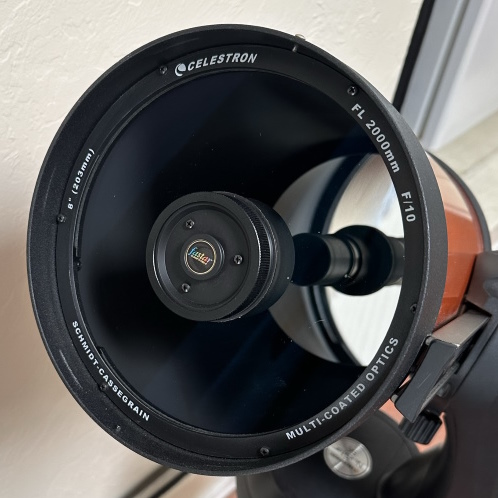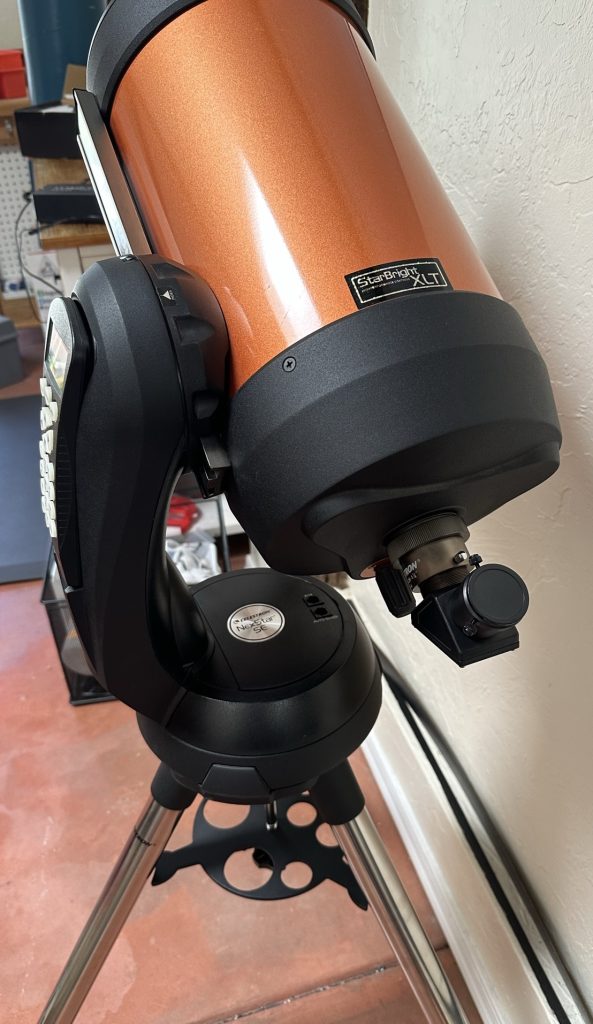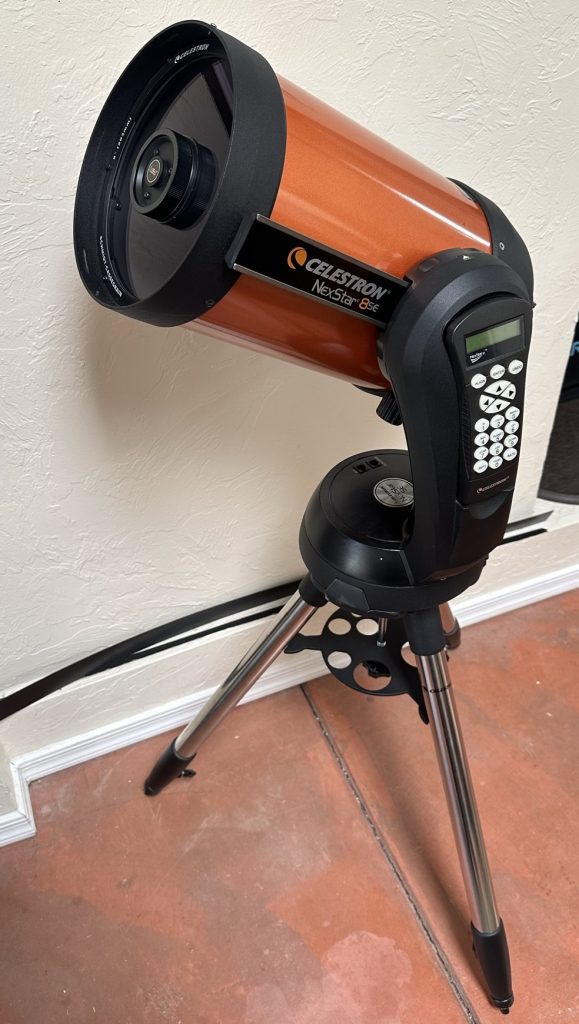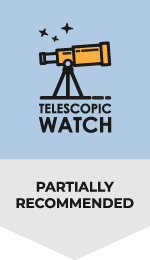The Optical Tube Performance
The Celestron NexStar 8SE optical tube is an 8” f/10 Schmidt-Cassegrain, otherwise known as the C8.
Since 1970, when the orange tube C8 made its debut, Celestron has been producing C8s in basically the same format. Although the scopes have undergone revisions in the exact design of the tube as well as being now featured with Celestron’s StarBright XLT coatings and Hyperstar compatibility, the C8 is more or less the same scope nearly forty years later.

The Celestron NexStar 8SE scope is pretty good optically, though collimation can be tedious as with any Schmidt-Cassegrain – you must point the scope at a star (or an artificial equivalent), defocus it, and adjust the three small screws on the secondary mirror until everything is lined up. You can replace the screws with thumbscrews such as Bob’s Knobs to make things easier, but the thumbscrews seem to cause the scope to become miscollimated more often and interfere with attaching the lens cap.
The Celestron NexStar 8SE has a long Vixen dovetail bar on the side of the optical tube, but it is largely decorative in purpose as the scope will only really balance with the dovetail slid all the way or nearly all the way forward in the saddle.
The 8SE’s moving-mirror focuser does cause some image shift (the wobbling of the primary mirror on the rod causes the field of view to jiggle when focusing), but nothing too severe.
The back of the 8SE optical tube has the industry-standard Schmidt-Cassegrain threads, which allow you to attach a variety of accessories such as a 2” star diagonal, focal reducer, DSLR T-adapter, and various other items.
Reviewing the Accessories
The Celestron NexStar 8SE computerised telescope comes with a single eyepiece – Celestron’s “E-Lux” 25mm Plossl – and a 1.25” star diagonal and visual back. The included 1.25” diagonal is a prism of very high quality.

While the 25mm Plossl works well for low power, you will probably want a 2” diagonal and wide-angle 2” eyepiece for low power, and various 1.25” eyepieces for higher magnifications. You can attach a 2” diagonal simply by unthreading the 1.25” visual back and threading a 2” diagonal for SCTs on in place, or by purchasing a 2” visual back and a 2” diagonal with a 2” nosepiece—the latter is less convenient, but there are more refractor diagonals to choose from.
The Celestron NexStar 8SE’s finderscope is a simple red dot finder, which is all you need to align the GoTo system—after alignment is complete, you don’t really need a finder at all.
Mount Capabilities of the 8SE
The Celestron NexStar 8SE’s mount is the same as the one supplied with the NexStar 6SE. While it does work pretty well with the C8 optical tube assembly, it is not ideal to support the telescope and can be jiggly at high magnifications, particularly if you are using any heavy accessories or have the legs extended. This also presents the problem that you could knock the scope out of alignment if you’re not careful. Celestron’s Vibration Suppression Pads, while mildly inconvenient to deal with, will alleviate some of the jiggles with this scope, but not completely.

The 8SE mount takes eight AA batteries, but we recommend only using these as a backup – get a portable 12-volt DC power supply and cord (Celestron even sells some meant specifically for astronomical use). However, you should always keep AA batteries in the scope’s battery compartment because if external power is lost accidentally and there is no internal backup, the scope will have to be rebooted and re-aligned.
The NexStar 8SE’s hand controller contains a catalogue of about 40,000 objects. While the 8” aperture can show an impressive number of deep-sky objects and double stars, most of the 40,000 objects in the NexStar database are simply uninteresting, unaccompanied stars.
The 8SE mount has a Vixen saddle, and thus it can, in theory, take other optical tubes, but nothing besides a similar-sized or smaller Schmidt-Cassegrain or Maksutov-Cassegrain will be able to clear the base.
Should I buy a used Celestron NexStar 8SE?
A used 8SE isn’t bad, and if you can get it at a low enough price (or as an optical tube only), it’s worth considering sticking it on a different mount such as a CG-5, Advanced VX, HEQ5, or Celestron’s beefier NexStar Evolution mount.
The 8SE isn’t exactly a scope we would recommend thanks to its less-than-steady mount, super-long focal length, and fairly high price for what you get. There are other scopes worth considering from Celestron and other manufacturers, with or without computers. Here are some of our top alternative picks.
Under £800
- The StellaLyra 10″/Zhumell Z10/Orion SkyLine 10 offers significantly more (56%) more light gathering ability and a slight uptick in resolution compared to the 8SE. More important, however, are the simplicity and stability of the provided Dobsonian mount and the included accessories such as a 2” wide-angle eyepiece and laser collimator (along with the built-in 2” dual-speed Crayford focuser). The AD10/Z10 is rock solid and easy to aim, with an arguably similar form factor to the 8SE when stored or transported.
- The StellaLyra 8”/Zhumell Z8/Orion SkyLine 8 offers similar performance to the NexStar 8SE, but its shorter focal length and 2” dual-speed Crayford focuser allow for a much wider achievable field of view, and the Dobsonian mount is steadier, simpler, and easier to use – plus there’s the plethora of included accessories and the much lower price tag.
- The Explore Scientific 10” Hybrid Dobsonian not only offers more light gathering ability and resolving power (56% and 25% respectively) than the NexStar 8SE, but collapses down into a significantly more compact form factor when the truss tube is dismantled. It also of course features an ultra-stable and easy-to-aim Dobsonian mount, and a 2” single-speed Crayford focuser. Like the 8SE, you don’t get a lot of accessories to start out with, but this scope is a lot cheaper.
- The Sky-Watcher Virtuoso GTi 150P has less aperture than the NexStar 8SE, but its wide field and ultra-compact form factor might be just the ticket if you need a super-portable telescope. The collapsible tube and tabletop Dobsonian mount allow you to transport this scope in luggage or a large backpack, the GoTo mount is easily controlled via your smartphone or tablet (or just aimed manually!) and setup takes seconds. A manual version, the Heritage 150P, is also available at an even lower price tag, along with 130mm computerized and manual versions under the Virtuoso GTi and Heritage product lines respectively.
£800-£1200
- The StellaLyra 12”/Zhumell Z12/Orion SkyLine 12 offers more than double (2.25x more to be exact) the light gathering ability of the NexStar 8SE and 50% more resolving power. You get the same great features and accessories provided with the smaller AD/Z series deluxe Dobsonians, and with a large vehicle and/or a hand truck transporting this scope is hardly any more difficult than the 8SE – if nothing else, it’s only two pieces to worry about. However, make sure you can handle this massive scope before committing yourself; it’s always possible to start smaller and upgrade to something like the AD12 or an even bigger Dobsonian later.
- The Celestron StarSense Explorer 10” Dobsonian offers some computerized capability thanks to the handy StarSense Explorer technology, as well as an easy-to-aim Dobsonian mount and fairly lightweight/portable design thanks to its weight-optimized base and built-in carry handles. Like the 8SE only a single eyepiece and red dot finder are provided, but upgrading later on (or preferably right away) is easy enough. An 8” model is also available, but the 10” scope is more capable, not much heavier, and doesn’t require tools to adjust the primary mirror for collimation like the 8” StarSense Explorer Dob does.
- The Explore Scientific 10” Truss Tube Dobsonian is extremely compact and portable, and features a dual-speed 2” Crayford focuser. Its mount is rock-solid and buttery smooth, and a 10” scope of course offers more light gathering ability and resolving power than an 8” like the NexStar 8SE. However, as with the 10” Hybrid, you don’t get any good accessories and a shroud is required – plus, upgrading the 10” Hybrid to a dual-speed focuser is likely to be cheaper than purchasing the drastically more expensive 10” Truss model.
- The Celestron NexStar 6SE is steadier than the 8SE due to the lower weight of its optical tube on the single-armed fork mount, and the scope is a lot more compact allowing for airline transport or fitting in a padded case or backpack. However, you do give up some performance from the 8SE due to the smaller 6” of aperture.
Over £1200
- The Celestron NexStar Evolution 8” is essentially (as the name implies) an evolved and vastly superior version of the NexStar 8SE. A pair of Plossl eyepieces are included as a standard so there’s no need to get anything else right away, the tripod is rock-solid, the mount arm is less jittery, you get a built-in lithium battery instead of having to worry about burning AAs or wiring up an external power supply, and you can connect to the telescope and control it with an app like SkySafari or use it with the provided hand controller. If you like the 8SE and want something without compromises, we would certainly recommend the Evolution 8” in its place. The Evolution 6” is also a great pick, though the advantages of it versus the steadier and more reasonably priced 6SE are less pronounced, especially for the money.
- The Sky-Watcher 8” or 10” FlexTube GoTo are significantly steadier than the 8SE and their shorter focal length allows for a wider possible field of view. Either model can also be aimed manually without upsetting the alignment of the GoTo system, and the Dobsonian mount is free of the obnoxious jitters of the undersized and wobbly 8SE mount and tripod.
- The Explore Scientific 12” Truss Tube Dobsonian provides significantly more light gathering and resolving power (2.25x more and 50% more respectively) in a compact, portable package with high-quality, all-metal construction. The Dobsonian mount is buttery smooth, will balance with even the heaviest eyepieces, and is a joy to aim around the sky. You also get a high-quality dual-speed 2” Crayford focuser built in. However, as with most Explore Scientific offerings, the provided red dot finder is basically useless and the single included eyepiece is neither adequate nor particularly high quality to begin with, and you also need other upgrades like a shroud to keep stray light and moisture away from the telescope’s sensitive optics.
- The Celestron Advanced VX 8” SCT is not quite as lightweight nor quick to set up as the 8SE or NexStar Evolution 8, but is rock steady and more suited for astrophotography. You can get fabulous results doing planetary imaging, and deep-sky imaging with an f/6.3 reducer or Starizona HyperStar is possible – or swap out the C8 optical tube for a small, fast refractor or reflector for less hassle or money spent.
Aftermarket Accessory Recommendations
The NexStar 8SE, as with the other NexStar SE telescopes, arrives with very few accessories, and it’s essential to acquire several critical upgrades and supplementary eyepieces to fully utilise this telescope’s capabilities. A dew shield should be your first purchase, helping to reduce the effects of any nearby sources of glare (or from light pollution and moonlight) as well as keep your corrector plate free of moisture, which can lead to dew and frost wrecking your view and damaging the scope’s delicate optical coatings over time.
We strongly recommend acquiring a 2″ star diagonal for your NexStar 8SE, as it enables the ability to get a significantly wider field of view at low magnifications with the 8SE’s optical tube compared to using only 1.25″ eyepieces. Additionally, a screw-on dielectric mirror diagonal provides a slightly crisper image than the supplied 1.25″ prism unit, while also offering a more secure connection between your telescope and eyepieces.
Since the 8SE only includes a single 25mm Plossl eyepiece, you’ll of course want to pick up a few additional oculars for a wider range of magnifications and to enable a wider low-power field of view, the latter being the ideal situation for a 2” SWA eyepiece like the 38mm PanaView SWA eyepiece (53x). The 38mm PanaView or a similar eyepiece allows the widest achievable field of view that can be had with a 2″ eyepiece, perfect for expansive views of large deep-sky objects such as open star clusters with your 8SE. A 16mm UWA (127x) is excellent for medium-high magnification, as is a 15mm redline for 135x if you have a limited budget. A 10mm UWA or 9mm redline (203x or 226x) delivers the maximum magnification that atmospheric conditions – or the 8SE’s rather unsteady tripod – usually permit.
If you regularly experience exceptionally stable seeing conditions and can keep the 8SE from being too wobbly, a 7mm UWA or planetary eyepiece (290x) might also be a worthwhile investment. A set of vibration suppression pads may improve the 8SE’s stability situation somewhat, but is no substitute for a beefier and higher quality mount and tripod.
A UHC nebula filter can be screwed onto your eyepieces (or a 2″ to 1.25″ adapter, should you have acquired a 2” diagonal) and enhances views of nebulae with the C8 XLT. Although the scope’s limited field of view isn’t ideal for enormous objects like the Veil Nebula, the filter aids in observing smaller objects like the Orion or Crab Nebula by improving their contrast against the often-bright sky background, a particularly useful ability to have under light-polluted skies.
Finally, you’ll want a power supply such as the Celestron PowerTank Lithium to avoid churning through too many disposable batteries (a far more costly situation over time than picking up the PowerTank) with the 8SE and avoid the issues of tangled or accidentally unplugged extension cords. If you wish, the 8SE can also be controlled over WiFi with the Celestron SkyPortal app or SkySafari Pro using the SkyPortal WiFi adapter, mimicking the Astro Fi and NexStar Evolution telescopes.
What Can You See with the Celestron NexStar 8SE?
Once initial setup, alignment, and collimation are out of the way, the 8” aperture of the NexStar 8SE computerised telescope will show you a lot.
In the solar system, you can explore:
- Mercury and Venus’ phases
- The Moon’s ridges, faults, valleys, mountains, flatlands, craters, and more – any feature bigger than a mile is visible provided there are good atmospheric conditions and collimation.
- Mars’ albedo shading, ice cap, and dust storms
- Jupiter’s bands, cloud belts, Great Red Spot, and the moons as tiny coloured disks
- Saturn’s rings and the division in them, its cloud belts, and a half dozen moons
- Uranus as a small turquoise disk, with possibly a moon or two.
- Neptune and its moon Triton
Outside the solar system, you can complete the entire Messier catalogue, given half-decent skies, and even the Herschel 400 catalogue with effort. Thousands of galaxies and star clusters, as well as hundreds of nebulae, are yours to explore – all readily accessible with the 8SE’s GoTo system.
How Good Is the 8SE For Astrophotography?
The Celestron NexStar 8SE is capable of very good lunar and planetary astrophotography with either a CCD camera or a DSLR – both need a 2x or 3x Barlow lens for optimal sampling, and the latter requires a T-adapter. Just take a couple minutes of video and process it with the free programmes Registax or AutoStakkert.
Simple deep-sky astrophotography of objects like the Orion Nebula and Andromeda Galaxy is possible with the NexStar 8SE provided you obtain Celestron’s f/6.3 reducer and keep exposure times to under twenty or thirty seconds – any longer than that and the alt-azimuth mount’s field rotation and small inaccuracies in the tracking will blur your images. You could buy a Starizona HyperStar and do longer exposures (as well as get a wider field and more detail with the same exposure length), but an equatorially-mounted apochromatic refractor is probably a better choice for the beginner astrophotographer than the 8SE with HyperStar.


